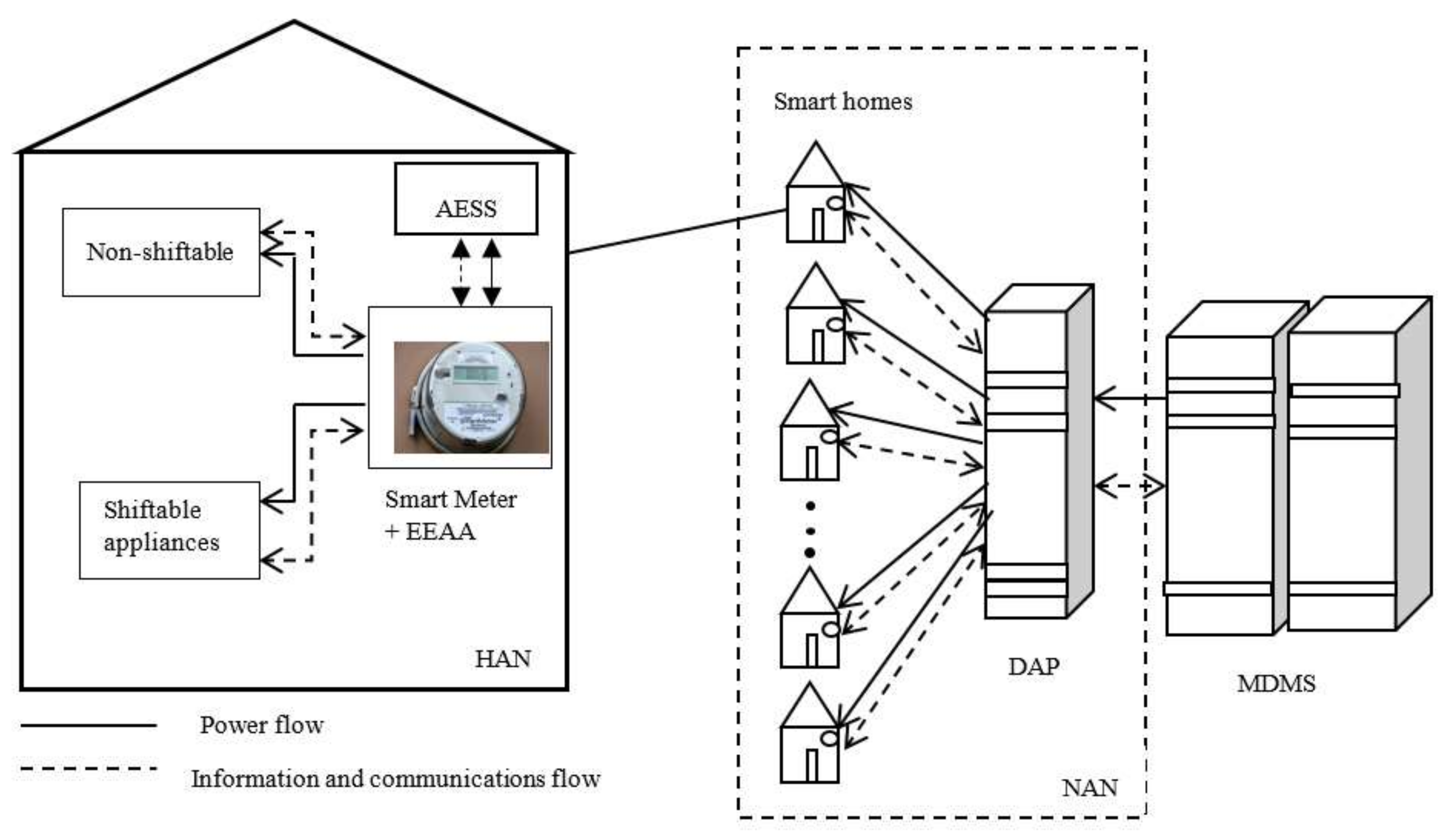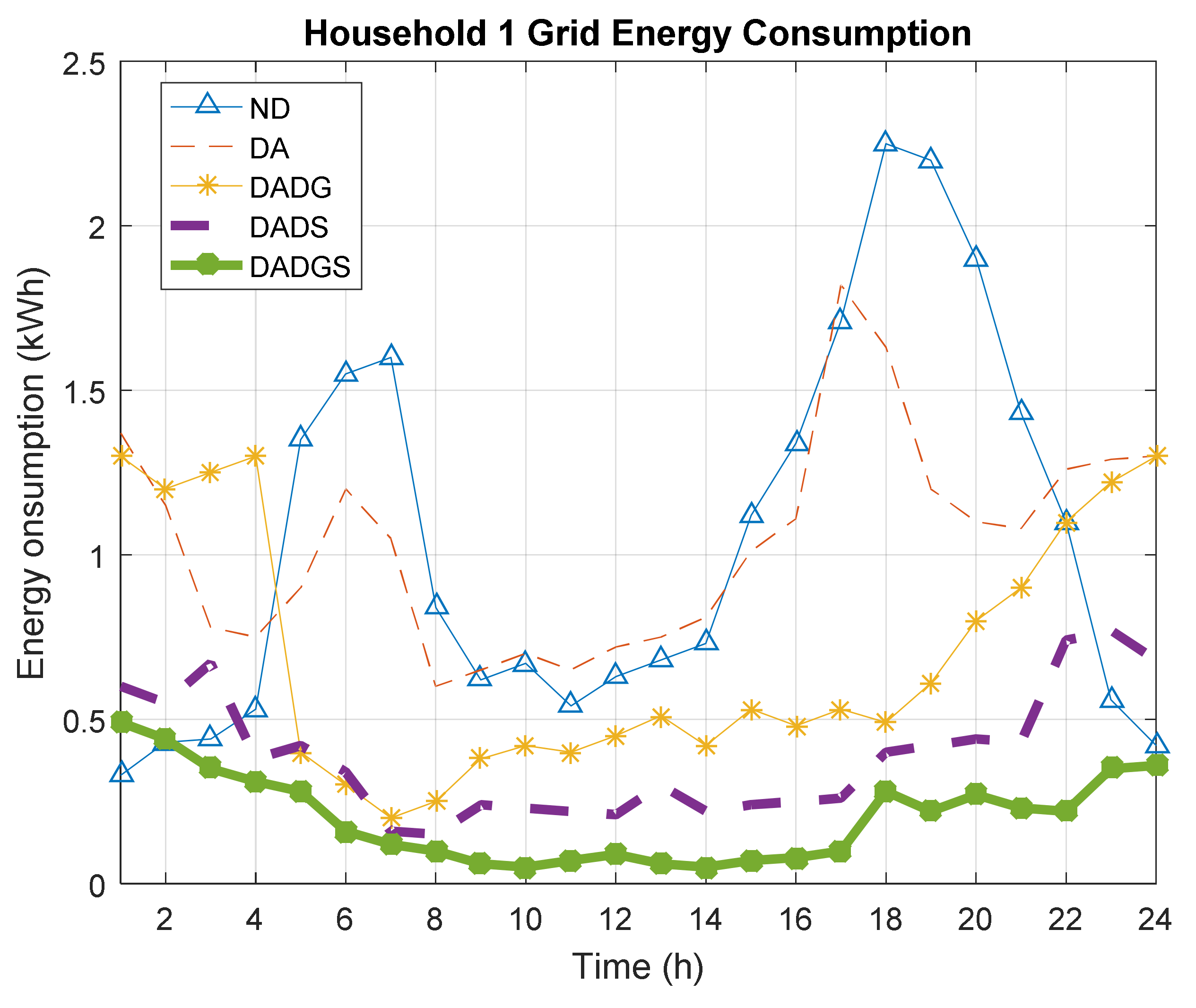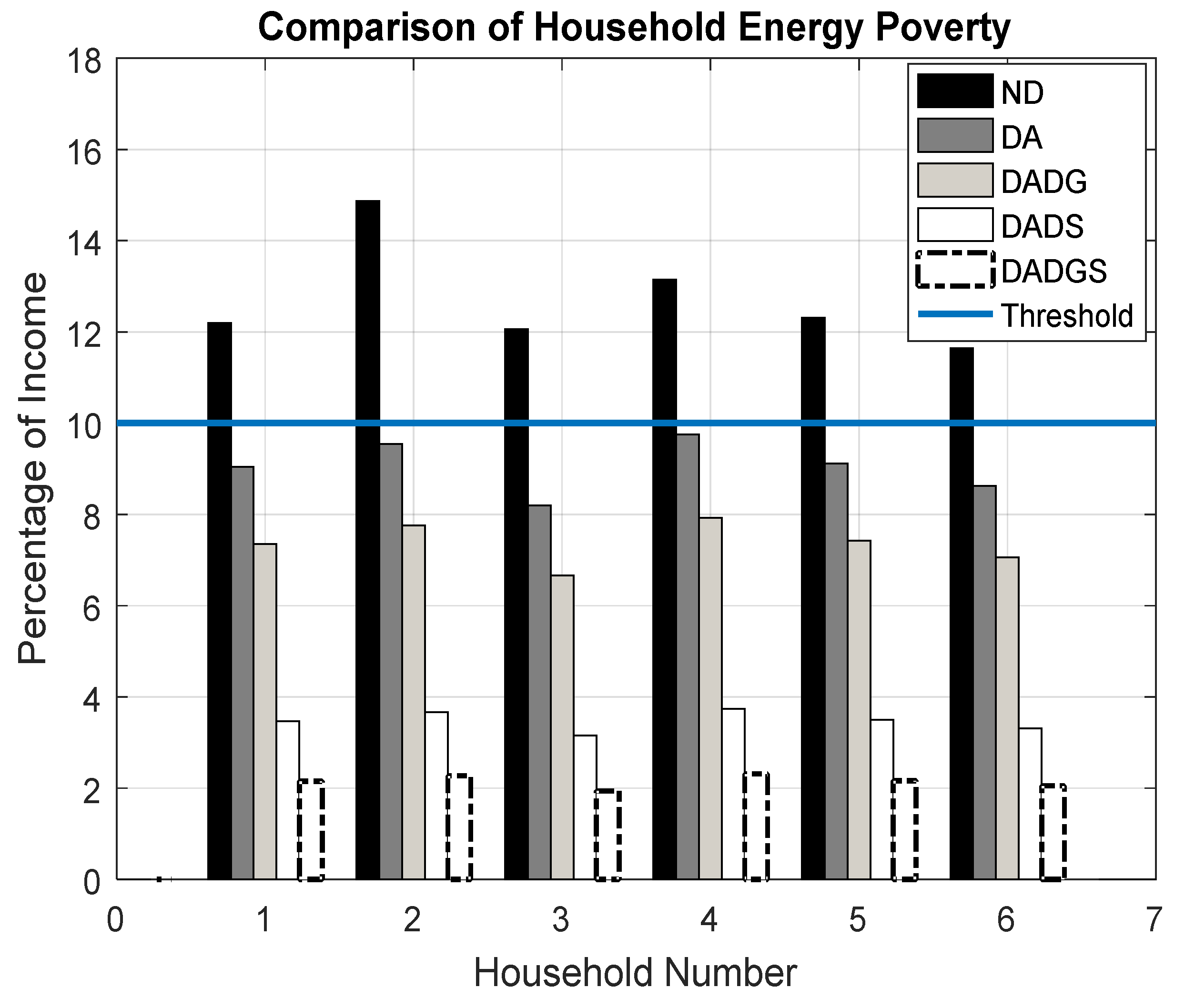Mitigating Household Energy Poverty through Energy Expenditure Affordability Algorithm in a Smart Grid
Abstract
:1. Introduction
2. Household Income and Energy Expenditure Affordability
3. EEAA Framework for DSM in Smart Homes
3.1. Description of the EEAA Architecture
3.2. EEAA Mathematical Formulation
3.3. EEAA Optimisation Problem
4. Numerical Results and Discussion
5. Conclusions
Author Contributions
Conflicts of Interest
References
- Barnes, D.F.; Khandker, S.R.; Samd, H.A. Energy Access, Efficiency and Poverty: How Many Households are Energy Poor in Bangladesh; The World Bank Development Research Group—Agriculture and Rural Development Team, Policy Research Working Paper 5332; World Bank: Washington, DC, USA, 2010; pp. 1–50. [Google Scholar]
- Department of Energy, South Africa. A Survey of Energy-Related Behaviour and Perceptions in South Africa; The residential sector; Department of Energy, South Africa: Pretoria, South Africa, 2012. [Google Scholar]
- Schuessler, R. Energy Poverty Indicators: Conceptual Issues, Part I: The Ten-Percent-Rule and Double Median/Mean Indicators; Centre for European Economic Research: Mannheim, Germany, 2014. [Google Scholar]
- Tushar, M.H.K.; Zeineddiner, A.W.; Assi, A. Demand side management by regulating charging and discharging of the EV, ESS and utilizing renewable energy. IEEE Trans. Ind. Inform. 2018, 14, 117–126. [Google Scholar] [CrossRef]
- Goebel, C.; Cheng, V.; Jacobsen, H.A. Profitability of residential battery energy storage combined with solar photovoltaics. Energies 2017, 10, 976. [Google Scholar] [CrossRef]
- Longe, O.M.; Ouahada, K.; Rimer, S.; Ferreira, H.C.; Vinck, H. Distributed Optimisation Algorithm for Demand Side Management in a Grid-Connected Smart Microgrid. Sustainability 2017, 9, 1088. [Google Scholar] [CrossRef]
- Cortes, P.; Munuzuri, J.; Berrocal-de-O, M.; Domingnez, I. Gnetic algorithms to optimize the operating costs of electricity and heating networks in buildings considering distributed energy generation and storage. Comput. Oper. Res. 2018, 1–16. [Google Scholar] [CrossRef]
- Longe, O.M.; Ouahada, K.; Rimer, S.; Harutyunyana, A.N.; Ferreira, H.C. Distributed demand side management with battery storage for smart home energy scheduling. Sustainability 2017, 9, 120. [Google Scholar] [CrossRef]
- Hussain, H.M.; Javaid, N.; Iqbal, S.; Hasan, Q.U.; Aurangzeb, K.; Alhussein, M. An efficient demand side management system with a new optimimised home energy management controller in smart grid. Energies 2018, 11, 190. [Google Scholar] [CrossRef]
- Di Santo, K.G.; Di Santo, S.G.; Monaro, R.M.; Saidel, M.A. Active demand side management for households in smart grids using optimisation and artificial intelligence. Measurement 2018, 115, 152–161. [Google Scholar] [CrossRef]
- Maharjan, S.; Zhu, Q.; Zhang, Y.; Gjessing, S.; Basar, T. Demand response management in the smart grid in a large population regime. IEEE Trans. Smart Grid 2016, 7, 189–199. [Google Scholar] [CrossRef]
- Viani, F.; Salucci, M. Auser perspective optimisation scheme for demand-side energy management. IEEE Syst. J. 2017, 1–4. [Google Scholar] [CrossRef]
- Wang, Y.; Saad, W.; Mandayam, N.B.; Poor, H.V. Load shifting in the smart grid—To participate or not? IEEE Trans. Smart Grid 2016, 7, 2604–2614. [Google Scholar] [CrossRef]
- Ye, M.; Hu, G. Game design and analysis for price-based demand response—An aggregate game approach. IEEE Trans. Cybern. 2017, 47, 720–730. [Google Scholar] [CrossRef] [PubMed]
- Khalid, A.; Javaid, N.; Guizan, M.; Alhussein, M.; Aurangzeb, K.; Ilahi, M. Towards dynamic coordination among home appliances using multi-objective energy optimization for demand side management in smart buildings. IEEE Access 2018, 99, 1–21. [Google Scholar] [CrossRef]
- Baurzhan, S.; Jenkins, G.P. On-grid solar PV versus diesel electricity generation in sub-Saharan Africa: Economics and GHG emissions. Sustainability 2017, 9, 372. [Google Scholar] [CrossRef]
- Vaserstein, L.N. Introduction to Linear Programming; Pearson Educational Inc.: Upper Saddle River, NJ, USA, 2003. [Google Scholar]
- Auffhammer, M.; Wolfram, C.D. Powering up China: Income distributions and residential electricity consumption. Am. Econ. Rev. 2014, 104, 578–580. [Google Scholar] [CrossRef]
- Fankhauser, S.; Tepic, S. Can Poor Consumers Pay for Energy and Water? An Affordability Analysis for Transition Countries; European Bank for Reconstruction and Development: London, UK, 2007. [Google Scholar]
- Mirzatuny, M. Energy Management Can Empower Everyone Regardless of Income Level. Environmental Defense Fund, US Climate and Energy Programme. 2014. Available online: www.blogs.edf.org (accessed on 12 May 2017).
- McAllister, A. Energy Costs, Conservation, and the Poor. Available online: www.reimaginerpe.org/node/965 (accessed on 12 May 2017).
- Longe, O.M.; Ouahada, K.; Rimer, S.; Ferreira, H.C. Optimization of energy expenditure in smart homes under Time-of-Use pricing. In Proceedings of the IEEE ISGT—Asia, Bangkok, Thailand, 3–6 November 2015; pp. 1–6. [Google Scholar]
- South African Advertising Research Foundation (SAARF). Developmental Indicators-Poverty and Inequality. 2014. Available online: www.saarf.co.za/development-indicators-poverty-and-inequality.pdf (accessed on 23 February 2016).
- Statistics South Africa (STATS SA). Statistical Release P0318—General Household Survey 2016. Available online: http://www.statssa.gov.za/?p=9922 (accessed on 4 April 2018).
- National Energy Regulator of South Africa (NERSA). Eskom’s 2015/16 Time of Use (TOU) Structural Adjustment. Available online: www.nersa.gov.za/eskom-tou-structural-adjustment.pdf (accessed on 1 April 2017).
- Eskom. Tariffs and Charges Booklet 2016/2017. 2016. Available online: http://www.eskom.co.za/CustomerCare/TariffsAndCharges/Documents (accessed on 12 May 2017).
- Shaukat, N.; Ali, S.M.; Mehmood, C.A.; Khan, B.; Jawad, M.; Farid, U.; Ullah, Z.; Anwar, S.M.; Majid, M. A survey on consumers empowerment, communication technologies, and renewable generation penetration within smart grid. Renew. Sustain. Energy Rev. 2018, 81, 1453–1475. [Google Scholar] [CrossRef]
- Kabalci, Y. A survey on smart metering and smart grid communication. Renew. Sustain. Energy Rev. 2016, 57, 302–318. [Google Scholar] [CrossRef]
- Keogh, E.; Ratanamahatana, C.A. Exact indexing of dynamic time warping. In Knowledge and Information Systems; Springer: Berlin, Germany, 2004; pp. 1–29. [Google Scholar]
- Berndt, D.; Clifford, J. Using dynamic time warping to find patterns in time series. In Proceedings of the 3rd International Conference on Knowledge Discovery and Data Mining, Seattle, WA, USA, 31 July–1 August 1994; pp. 229–248. [Google Scholar]
- Wang, C.; de Groot, M. Managing end-user preferences in the smart grid. In Proceedings of the 1st International Conference on Energy-Efficient Computing and Networking, Passau, Germany, 13–15 April 2010; pp. 105–114. [Google Scholar]
- Kupzog, F.; Zia, T.; Zaidi, A.A. Automatic electric load identification in self-configuring microgrids. In Proceedings of the IEEE Africon 2009, Nairobi, Kenya, 23–25 September 2009; pp. 1–5. [Google Scholar]
- IBM. IBM ILOG CPLEX Optimisation Studio—Getting Started with CPLEX; Version 12; IBM Corporation: Armonk, NY, USA, 2011. [Google Scholar]
- Efergy Engage. Home Monitoring. Available online: https://engage.efergy.com//#home (accessed on 16 April 2017).
- Council for Scientific and Industrial Research (CSIR), Pretoria, South Africa. Johannesburg Solar Irradiation Data. Available online: www.csir.co.za (accessed on 22 July 2016).
- Tesla Motors. Tesla Energy. Available online: https://www.teslamotors.com/presskit/teslaenergy (accessed on 18 October 2017).
- Akila, A.; Chandra, E. Slope finder—A distance measure for DTW based isolated word speech recognition. Int. J. Eng. Comput. Sci. 2013, 2, 3411–3417. [Google Scholar]
- South African National Energy Development Institute (SANEDI). Hybrid Technologies in South Africa Full Report; South African National Energy Development Institute (SANEDI): Sandton, South Africa, 2018. [Google Scholar]
- Department of Environmental Affairs and Development Planning. Peak Demand Management Fact Sheet. Department of Environmental Affairs and Development Planning: 2014. Available online: https://www.westerncape.gov.za/text/2006/1/5_peak_demand_management.pdf (accessed on 23 March 2015).
- Siddiqui, O. The Green Grid—Energy Savings and Carbon Emissions Reductions by a Smart Grid; Technical Update; Electric Power Research Institute: Palo Alto, CA, USA, 2008. [Google Scholar]
- Longe, O.M.; Ouahada, K.; Ferreira, H.C.; Rimer, S. Consumer preference electricity usage plan for demand side management in the smart grid. S. Afr. Res. J. 2017, 104, 174–183. [Google Scholar]
- Pather-Elias, S.; Reddy, Y.; Radebe, H. Energy Poverty and Gender in Urban South Africa; Sustainable Energy Africa: Cape Town, South Africa, 2017. [Google Scholar]






| Quintiles | Income | Average Energy Expenditure | Population Spending More Than 10% of Income on Energy Expenditure |
|---|---|---|---|
| Upper quintile | R57,000 and above | 6% | 13% |
| 4th quintile | R21,003–R57,000 | 11% | 38% |
| 3rd quintile | R9887–R21,002 | 14% | 51% |
| 2nd quintile | R4544–R9886 | 17% | 65% |
| Lower quintile | R4543 and below | 27% | 74% |
| Household Number | Average Monthly Income (ZAR) | Household Size | Initial Average Energy Expenditure (%) | Interest in Technology | |||
|---|---|---|---|---|---|---|---|
| DSM + EEAA | DSM + DES + EEAA | DSM + DEG + EEAA | DSM + DEGS + EEAA | ||||
| 1 | 5570 | 4 | 13 | SA | AG | AG | AG |
| 2 | 6700 | 4 | 13 | SA | AG | AG | AG |
| 3 | 7226 | 3 | 11 | SA | AG | AG | AG |
| 4 | 8975 | 5 | 13 | SA | SA | AG | AG |
| 5 | 9681 | 3 | 12 | SA | SA | AG | AG |
| 6 | 13,889 | 4 | 13 | SA | SA | SA | AG |
© 2018 by the authors. Licensee MDPI, Basel, Switzerland. This article is an open access article distributed under the terms and conditions of the Creative Commons Attribution (CC BY) license (http://creativecommons.org/licenses/by/4.0/).
Share and Cite
Longe, O.M.; Ouahada, K. Mitigating Household Energy Poverty through Energy Expenditure Affordability Algorithm in a Smart Grid. Energies 2018, 11, 947. https://doi.org/10.3390/en11040947
Longe OM, Ouahada K. Mitigating Household Energy Poverty through Energy Expenditure Affordability Algorithm in a Smart Grid. Energies. 2018; 11(4):947. https://doi.org/10.3390/en11040947
Chicago/Turabian StyleLonge, Omowunmi Mary, and Khmaies Ouahada. 2018. "Mitigating Household Energy Poverty through Energy Expenditure Affordability Algorithm in a Smart Grid" Energies 11, no. 4: 947. https://doi.org/10.3390/en11040947
APA StyleLonge, O. M., & Ouahada, K. (2018). Mitigating Household Energy Poverty through Energy Expenditure Affordability Algorithm in a Smart Grid. Energies, 11(4), 947. https://doi.org/10.3390/en11040947






